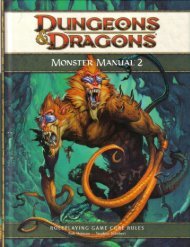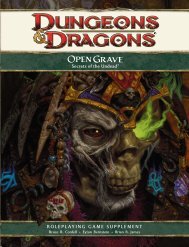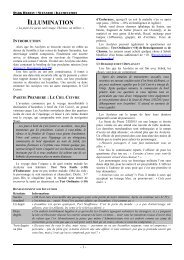You also want an ePaper? Increase the reach of your titles
YUMPU automatically turns print PDFs into web optimized ePapers that Google loves.
system, the skeleton between a dragon’s neck andrump—the bones of its legs and torso—somewhatresembles the skeleton of a great feline, although theneck and tail bones more closely resemble those ofserpents. The bones in and around the wings, like themuscles thereof, defy comparison.Dragon bone is strong. In fact, it is stronger thanany known nonmagical material other than adamantine,in terms of the amount of pressure it canwithstand. As with scales, when bone is removedfrom a dragon’s body, it becomes relatively brittle. Ifa person were to consider dragon bone as a buildingmaterial, good-quality stone or heavy wood wouldultimately make better choices because of their comparabledurability and wider availability.Dragon bones are hollow like those of birds,making them remarkably light for their size andstrength. The marrow within is yet another repositoryof the elemental energy that flows through thebloodstream.The sternum (1) serves as an anchor for a dragon’sflight muscles, and the scapula draconis (2) supportsthe wing. The metacarpis draconis (3) and alarphalanges (4) in each wing support the wing’s flightsurface.MetabolismPeople assume that <strong>dragons</strong> are cold-blooded dueto their apparently reptilian nature. In truth, adragon does not depend upon the environment forwarmth, but rather maintains a consistent internaltemperature. By broad definition, that makes <strong>dragons</strong>warm-blooded, but true warm-blooded creaturesmaintain their body temperature by increasing theirmetabolic rate when the environment grows coldand by slowing their metabolism and shedding heat—through sweating, panting, or similar methods—whenthe environment warms.The elemental energy flowing through a dragon’sbloodstream, on the other hand, maintains thewyrm’s proper range of internal temperatures,regardless of external environment. Even <strong>dragons</strong>whose breath weapons have no intrinsic temperaturerequirements—such as breath weapons of poison oracid—use that energy to maintain internal heat. Naturally,<strong>dragons</strong> that have fire- or heat-based attacksmaintain the highest body temperatures, and thosethat use cold or necrotic energy maintain low bodytemperatures.A dragon can enter a long sleep similar to a state ofhibernation. Such a sleep allows the creature to passdecades or even centuries without waking. Dragonsmight enter this sleep as a way of surviving periods offamine without having to find a new lair, grieving theloss of a loved one, or withdrawing from the world outof sheer ennui.DietBecause <strong>dragons</strong> make use of supernatural energy aspart of their digestive process, they can consume anddigest all sorts of food. They can also consume substancesthat wouldn’t qualify as food to other livingcreatures.Dragons are predators—instinctive hunters atthe top of the food chain. They find meat and otherorganic material the easiest fare to digest. Whenmeat is unavailable, <strong>dragons</strong> resort to eating largeplants, such as trees and large bushes.In emergencies, when the alternative is starvation,<strong>dragons</strong> might eat anything they can swallow: deadwood, rock, and other inorganic materials. Dragonsfind these substances distasteful. Furthermore, sincerock, for instance, holds little nutritional value, adragon must eat a lot more of such a substance than itneeds of organic material—at least as much as its ownbody weight per day to maintain health. Dragons considersuch measures humiliating, to the extent thatsome <strong>dragons</strong>, particularly reds, prefer to starve for atime rather than depend on food they weren’t meantto eat.The elemental aspect of a dragon’s digestivesystem, in addition to allowing the creature to eatsubstances others cannot, also makes it hyperefficientat digesting meats and other normal foods. Althougha dragon can consume more than half its body weightin such food over the course of a day—and many dojust that, with sufficient prey—a dragon needs to eatonly about 15 to 20 percent of its body weight inorganic food on a daily basis.At the other end of the scale, a dragon must eatan obscene amount of food to gain weight. Reports ofthe black dragon “Queen” Gulgol, one of the few trulyobese <strong>dragons</strong> known to modern-day sages and adventurers,say she eats more than twice her own bodyweight per day. (For more on Gulgol, see page 238.)Dragons might make use of their breath weaponseven when hunting prey that could not possibly survivea melee encounter. Some <strong>dragons</strong> breathe onprey that is already dead. Since <strong>dragons</strong> use the sameenergy in digestion that they use for their breath weapons,they find it easier to digest prey that they havealready bathed in their particular form of energy. Ared dragon, for instance, can more swiftly digest—andthus prefers the taste of—prey that has been charredby fire. White <strong>dragons</strong> find it easier to digest preywhen it is frozen solid, purple <strong>dragons</strong> have an easiertime with prey that has begun to decay, and so forth.Consuming Magic ItemsOn rare occasions, a dragon might consume magicitems rather than add them to its hoard. The creature’ssupernatural digestive system processes magicitems more easily than nonmagical objects; a dragongains as much nutrition from magic items as it does12CHAPTER 1 | Dragon Lore









